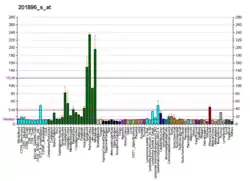Proline/serine-rich coiled-coil protein 1 is a protein that in humans is encoded by the PSRC1 gene.[5][6][7]
This gene encodes a proline-rich protein. Studies of the related mouse gene suggest that this gene is regulated by p53 and may participate in p53-mediated growth suppression. Alternatively spliced transcript variants encoding different isoforms have been described.[7]
References
- 1 2 3 GRCh38: Ensembl release 89: ENSG00000134222 - Ensembl, May 2017
- 1 2 3 GRCm38: Ensembl release 89: ENSMUSG00000068744 - Ensembl, May 2017
- ↑ "Human PubMed Reference:". National Center for Biotechnology Information, U.S. National Library of Medicine.
- ↑ "Mouse PubMed Reference:". National Center for Biotechnology Information, U.S. National Library of Medicine.
- ↑ Lo PK, Wang FF (Nov 2002). "Cloning and characterization of human and mouse DDA3 genes". Biochim Biophys Acta. 1579 (2–3): 214–8. doi:10.1016/s0167-4781(02)00512-2. PMID 12427559.
- ↑ Lo PK, Chen JY, Lo WC, Chen BF, Hsin JP, Tang PP, Wang FF (Feb 2000). "Identification of a novel mouse p53 target gene DDA3". Oncogene. 18 (54): 7765–74. doi:10.1038/sj.onc.1203167. PMID 10618717.
- 1 2 "Entrez Gene: PSRC1 proline/serine-rich coiled-coil 1".
Further reading
- Kathiresan S, Melander O, Guiducci C, et al. (2008). "Six new loci associated with blood low-density lipoprotein cholesterol, high-density lipoprotein cholesterol or triglycerides in humans". Nat. Genet. 40 (2): 189–97. doi:10.1038/ng.75. PMC 2682493. PMID 18193044.
- Wallace C, Newhouse SJ, Braund P, et al. (2008). "Genome-wide Association Study Identifies Genes for Biomarkers of Cardiovascular Disease: Serum Urate and Dyslipidemia". Am. J. Hum. Genet. 82 (1): 139–49. doi:10.1016/j.ajhg.2007.11.001. PMC 2253977. PMID 18179892.
- Beausoleil SA, Villén J, Gerber SA, et al. (2006). "A probability-based approach for high-throughput protein phosphorylation analysis and site localization". Nat. Biotechnol. 24 (10): 1285–92. doi:10.1038/nbt1240. PMID 16964243. S2CID 14294292.
- Gregory SG, Barlow KF, McLay KE, et al. (2006). "The DNA sequence and biological annotation of human chromosome 1". Nature. 441 (7091): 315–21. Bibcode:2006Natur.441..315G. doi:10.1038/nature04727. PMID 16710414.
- Wan D, Gong Y, Qin W, et al. (2004). "Large-scale cDNA transfection screening for genes related to cancer development and progression". Proc. Natl. Acad. Sci. U.S.A. 101 (44): 15724–9. Bibcode:2004PNAS..10115724W. doi:10.1073/pnas.0404089101. PMC 524842. PMID 15498874.
- Gerhard DS, Wagner L, Feingold EA, et al. (2004). "The Status, Quality, and Expansion of the NIH Full-Length cDNA Project: The Mammalian Gene Collection (MGC)". Genome Res. 14 (10B): 2121–7. doi:10.1101/gr.2596504. PMC 528928. PMID 15489334.
- Ota T, Suzuki Y, Nishikawa T, et al. (2004). "Complete sequencing and characterization of 21,243 full-length human cDNAs". Nat. Genet. 36 (1): 40–5. doi:10.1038/ng1285. PMID 14702039.
- Strausberg RL, Feingold EA, Grouse LH, et al. (2003). "Generation and initial analysis of more than 15,000 full-length human and mouse cDNA sequences". Proc. Natl. Acad. Sci. U.S.A. 99 (26): 16899–903. Bibcode:2002PNAS...9916899M. doi:10.1073/pnas.242603899. PMC 139241. PMID 12477932.
This article is issued from Wikipedia. The text is licensed under Creative Commons - Attribution - Sharealike. Additional terms may apply for the media files.




